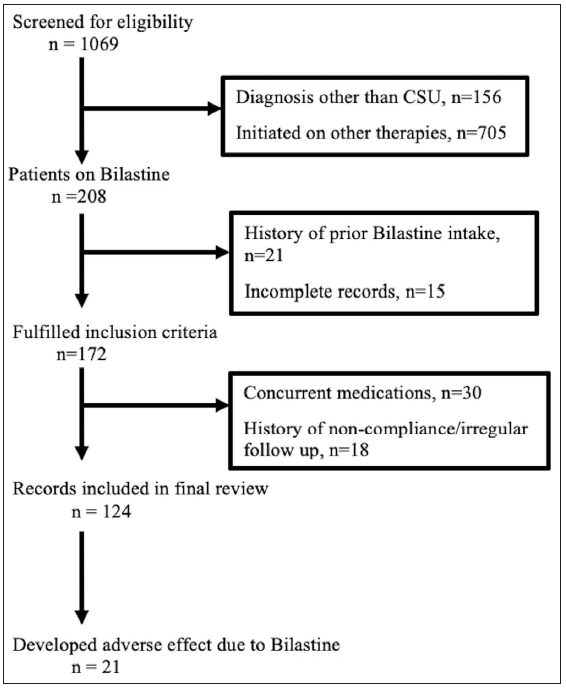Dear Editor,
Urticaria is a common, dermatological condition that wheals and/or angioedema with a lifetime presents with prevalence of 8.8 percent.1 Second-generation H1-antihistamines are preferred as the primary treatment for urticaria due to their enhanced peripheral H1-receptor selectivity, reduced lipophilicity and fewer adverse effects. Bilastine, belonging to this category, exhibits a high affinity for H1 histamine receptors. Bilastine is well-tolerated, with an absence of serious adverse events or fatalities. The most prevalent side effects, in decreasing order, include headache, followed by somnolence, fatigue and dyspnoea.2 The primary objective of this study was to evaluate the safety profile of bilastine within the Indian population in a real-world setting. This investigation was prompted by the need to bridge the gap between existing Western literature, which often asserts the absence of sedation with bilastine, and the notable instances of sedative effects commonly observed in our clinical practice among Indian patients.
A retrospective analysis of urticaria clinic records was conducted from January 2023 through December 2023. This retrospective study included patients aged 18 and above, newly initiated on bilastine therapy for chronic spontaneous urticaria, who had received bilastine monotherapy for at least 12 weeks. Exclusion criteria comprised pregnant or breastfeeding women, those with incomplete records, prior exposure to bilastine, concurrent significant concomitant medications, non-compliance history and inducible urticaria. The collected data included demographic information, comprising age and gender, as well as details on the duration of illness, and any reported adverse effects. Furthermore, the dataset included details on the dosage at the time of the observed adverse effects and the duration of bilastine use leading up to the onset of these adverse effects.
During the designated study timeframe, the urticaria clinic recorded a total of 1069 new patient registrations. Of these, 208 patients were initiated on bilastine therapy. Following the application of inclusion criteria, 172 patients were deemed eligible, while 48 were excluded based on various criteria. The study incorporated records from 124 patients diagnosed with chronic spontaneous urticaria [Figure 1]. Given that this study was a retrospective chart review during which we anonymised patient data at the point of collection, a waiver of consent from the institutional ethics committee was sought.

Export to PPT
Out of 124 chronic spontaneous urticaria patients, 23 (18.5%) reported experiencing one or more adverse effects upon initiating bilastine treatment [Figure 1]. The mean age of these patients was 37.2 ± 6.8 years of age (range: 25–45 years), including eight men and 15 women. The duration of illness ranged from 8 weeks to 3 years. Totally, 25 adverse effects were observed in 23 patients. Somnolence was the most prevalent side effect, affecting 11.20% of patients (n = 14), followed by headache at 2.41% (n = 3). Additionally, dizziness, abdominal pain and dyspepsia were reported by 1.6% of patients each (n = 2), while acneiform eruption and constipation were less frequent, each reported by 0.8% of patients (n = 1). In comparison to our study, dizziness was reported in 1% (n = 1/100), gastrointestinal (GI) side effects in 3% (n = 3/100) and acneiform eruption in 3% (n = 2/56) in other studies.3,4 The mean duration of therapy prior to the onset of adverse effects was 8.6 weeks (range: 2–20 weeks).
Among the 23 patients, seven experienced side effects at a lower bilastine dose (20 mg), while the remaining 16 encountered adverse effects at higher doses (≥40 mg), consistent with a study noting subjective sedation at 40 mg and objective psychomotor impairment at 80 mg.5 Incidence of somnolence was more in the high dose as compared to the low-dose group (p = 0.047, Fisher Exact test), while abdominal pain, dyspepsia and acneiform eruption were observed only in the high-dose group. Table 1 illustrates the variation in adverse effects with respect to bilastine dosage. Notably, up-dosing in two patients initially on bilastine 20 mg, experiencing headache and dizziness, was successfully performed without any escalation in the intensity of adverse effects. None of the observed adverse effects necessitated discontinuation of treatment.
Table 1: Variation in adverse effects with dose of bilastine
Bilastine 20 mg (n = 7/72) Bilastine >20 mg (n = 18/52)*Somnolence (n = 4, 5.5%)
Headache (n = 1, 1.4%)
Dizziness (n = 1, 1.4%)
Constipation (n = 1, 1.4%)
Somnolence (n = 10, 19.2%)
Headache (n = 2, 3.8%)
Dizziness (n = 1, 1.9%)
Abdominal pain (n = 2, 3.8%)
Dyspepsia (n = 2, 3.8%)
Acneiform eruption (n = 1, 1.9%)
Reports of sedation as an adverse effect varied across regions, with rates of 2% and 5.8% in studies from Japan and Germany, respectively.3,6 Conversely, earlier investigations in India documented sedation in 10.2% and 12.9% of patients, aligning closely with the rates observed in our study.7,8 The elevated occurrence of adverse effects in the Indian population, in contrast to Western literature, may be influenced by genetic variability, diverse lifestyle factors, environmental conditions and reporting biases. This emphasises the need for targeted research to better understand these specific influences on drug safety. Limitations of our study include a small sample size, retrospective design and potential reporting biases. Exclusions of specific urticaria subtypes and concurrent medications may impact generalisability. Despite these, the study emphasises the need for further research to understand observed differences in adverse effects.
In conclusion, bilastine is safe and well tolerated; nevertheless, one must be cautious and vigilant when increasing the dose of bilastine, and counsel the patient appropriately to identify and report the side effects.
留言 (0)